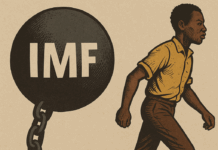By Peter Olorunnisomo – There is a lesson to be learnt from the Ethiopian leadership. It is noteworthy that ever since the Prime Minister, Abiy Ahmed Ali, receiving the people’s mandate, the focus of his administration has been the socio-economic and political reconstruction of Ethiopia.

Perhaps that is helped by the fact of looking, historically, at the prominence and political position of Ethiopia ‘yesterday’. The sense of patriotic fervour of a nation that prides itself on the premium of its ancestry and ancient civilisation certainly trends beyond the mere recognition of a peoples with a world renowned culture.
Recently, a core mark of political stability to create an enabling environment for peace and economic and developmental prosperity appears to be the recognition of the people’s will to have a female President, Sahle-Work Zewde, at the country’s parliament for the very first time.

A similar position occasioned the Peace and Reconciliation Commission in South Africa in the early years of the post-apartheid regime that the country may move on to more developmental issues rather than contend with grievances which could potential become another theatre of guerrilla warfare if not a barrage of civil disturbance. Either way, the country’s national security was not to be placed in the hands of a third party.
The shrewd sense of inclusion and the appropriation of political values to progress is very ably demonstrated by the several moves to bring back dissidents and forgive the sons of the soil who have worked against constituted authority.
Perhaps it is fortuitous that the rebels also see this and understand the value of returning home battle-weary and spirit-inclined to their cradle of existence. The return strategy has also seen to that of the exiled Oromia regional President months before.
So it was that former rebels belonging to Ethiopia’s Ogaden National Liberation Front, ONLF, on Wednesday returned to the country from their base in neighbouring Eritrea.
The contingent was flown from Asmara to Jijiga, capital of the Somali Regional State, SRS by an Ethiopian Airlines flight. They were received with cultural displays upon their arrival at the airport.
ONLF’s known Twitter handle earlier on Wednesday tweeted photos from Jijiga where they were being awaited by residents of SRS. “Somali people in Jijiga and the regional army prepare to welcome ONLA special forces from Asmara,” the tweet read.
The group’s spokesperson had told the Voice of America’s Somali service on Monday that they were returning to Ethiopia. The return forms part of a peace deal reached with the federal government.
‘It’s because of you our people sleep safe at night. Thank you for your service.’
The group in mid-November signed a peace deal with the Ethiopian federal government in Asmara, where they have been based.
As part of the deal “The two sides have reached a historical agreement regarding the political rights of the people from Somali Regional State and genuinely addressing the root causes of the conflict between ONLF and the Ethiopian government,” ONLF said in a tweet.
As at the last meeting, there was also the announcement of a joint committee established for further discussions. The first round of talks between the two parties was in September this year. Months earlier the Ethiopian parliament had struck them off a list of terrorist organizations whiles they also called a ceasefire.
Key facts about the ONLF rebels:
Group was formed in 1984 amid a resurgence of separatist sentiment in the ethnically Somali Ogaden region on Ethiopia’s border with Somalia.
Ethiopia had accused the ONLF of being terrorists supported by Eritrea, and launched a military offensive against the group.
The military action followed a rebel attack on a Chinese-run oil field that killed more than 70 people.
The insurgents’ aims have varied over time, ranging from full-scale independence to joining a “Greater Somalia”, to more autonomy within ethnically diverse Ethiopia.
ONLF fighters, who do not wear uniforms and are estimated to number several thousand.
They take advantage of their close ties with the area’s largely nomadic communities.
After hit-and-run attacks on military convoys, they often melt into villages and hide among herders when counter-attacks are threatened.
About the Ogaden region
The Ogaden region is almost entirely populated by Muslim, Somali-speakers. The region has kept its own distinctive identity, doing the bulk of its trade with Somaliland, Somalia and the Middle East rather than the rest of “highland” Ethiopia.
The separatist cause has been fuelled by widespread resentment at the region’s low level of development.
Until Chinese engineers arrived late last year, the entire region had only 30 km (20 miles) of tarmac road, all of it around the regional capital Jijiga. The area has also been battered by a succession of droughts and floods.
Kindly follow us on twitter:@AfricanVoice2









